The anterior cruciate ligament (ACL) is one of the most essential structures within the knee joint, playing a critical role in maintaining both stability and function. Positioned centrally within the knee, the ACL connects the femur (thigh bone) to the tibia (shin bone), acting as a stabiliser that prevents excessive forward movement of the tibia and controls rotational forces during dynamic activities.
Its importance becomes particularly evident during high-demand movements, such as sudden stops, pivots, or directional changes, making it integral to both athletic performance and everyday mobility. Despite its strength and functionality, the ACL is highly vulnerable to injury, often resulting in debilitating consequences that affect an individual’s physical capabilities and overall quality of life.
Prevalence and Impact
ACL injuries are alarmingly prevalent, especially within sports settings, where the physical demands on the knee are significant. Sports such as football, basketball, rugby, and skiing, which require quick acceleration, deceleration, jumping, and lateral movements, account for the majority of ACL injuries. Athletes, both amateur and professional, are frequently affected, but the injury is not limited to those participating in sports. Non-athletes can also experience ACL injuries during recreational activities, accidents, or even routine tasks like climbing stairs or slipping. The sudden, often traumatic nature of these injuries underscores the ACL’s vulnerability under specific mechanical stresses.
The impact of an ACL injury is multifaceted and extends beyond the immediate physical trauma. Athletes often face extended periods of absence from their sport, which can be mentally and emotionally challenging as they battle with feelings of frustration, loss, and isolation. For non-athletes, ACL injuries can disrupt daily routines, hinder work roles, and limit recreational hobbies. These injuries often lead to significant lifestyle adjustments, reducing independence and quality of life. Additionally, the financial costs associated with ACL injuries are substantial. Expenses for diagnoses, surgery, physiotherapy and rehabilitation, coupled with potential loss of income during recovery, make ACL injuries a significant burden not only for individuals but also for global healthcare providers.
The Importance of Understanding ACL Injuries
The widespread nature of ACL injuries and their profound impact on individuals’ lives highlights the critical need for education and awareness. Understanding the causes of ACL injuries, the biomechanics behind their occurrence, and the risk factors that predispose individuals to them is essential for both prevention and effective management. By examining the circumstances under which these injuries are most likely to occur, whether in high-intensity sports or daily activities, individuals and medical professionals can adopt proactive measures to reduce their popularity.
Equally important is knowledge of the available treatment options. Surgical advancements, such as minimally invasive techniques and improved graft options, have revolutionised ACL reconstruction, offering more successful outcomes and shorter recovery times. However, non-surgical treatments, including bracing and targeted physiotherapy, are also possible for some patients, depending on the severity of the injury, their activity levels and their overall goals in terms of recovery outcomes.
Rehabilitation strategies, tailored to restore strength, stability, and range of motion, are crucial in ensuring a full recovery and preventing re-injury. For athletes, this often involves not only regaining pre-injury performance levels but also addressing psychological barriers to returning to sport which are understandable when you think about the fear of going through that recovery journey again.
Prevention, however, remains the most effective strategy for reducing the incidence of ACL injuries. Training programmes that focus on neuromuscular conditioning, strengthening of stabilising muscles, and improvement of movement mechanics have been shown to significantly lower the risk of injury. Raising awareness about these preventative measures, particularly among at-risk populations such as young athletes, can lead to long-term benefits for individuals and communities.

